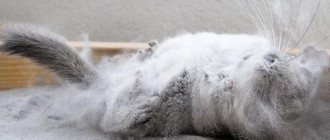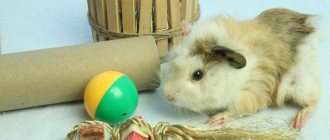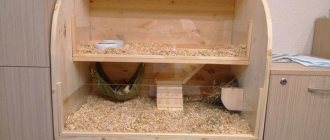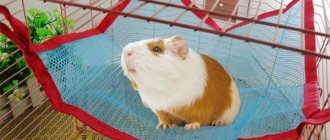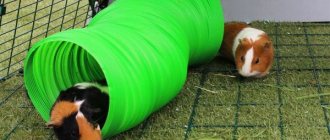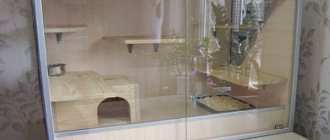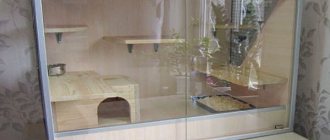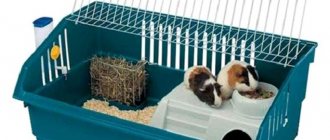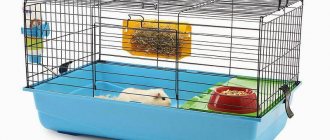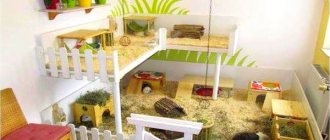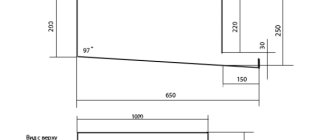What should the water be like?
Guinea pigs drink often and a lot, so it is important for your pet's health to monitor the condition of the water.
Temperature
Ice water can cause pneumonia, so choose room temperature.
Quality
Using tap water, filter it.
Freshness
Change the water at least once a day, and if possible increase it to 2-3 times. You should not feed your guinea pig stagnant water. Accumulated bacteria will lead to serious illness.
How to choose a drinking bowl for a rodent
When visiting a pet store, the buyer does not always know which drinking bowl is best to purchase.
The first thing you will notice is the different volume. From 50 ml to 300 ml, there are more, but these are not widely available and are rarely found on store shelves.
A small water bowl is suitable for a hamster or a rat, and they are also very convenient when you go to an exhibition. It is much more profitable to purchase such pet products wholesale than retail. Chinchilla, guinea pig and rabbit will need a larger volume. On average, we change the water once a day, which means the container must hold at least the daily amount consumed by the rodent. Not all drinking bowls can be topped with water. Many are a bottle with a screw-on cap. Such drinking bowls must be filled completely, otherwise water will either not flow into the spout, or, on the contrary, it will constantly leak.
Read more about the types.
Drinkers come in nipple and ball types. They have different operating principles.
Nipple - water flows into the spout as in a country washbasin.
Ball-type - the spout is located at an angle relative to the bottle; a ball is inserted into it, which moves freely along the spout. Naturally, when the bottle is in a vertical position, the ball is at the bottom and water does not flow out.
Both types of drinkers are widely used, and each has its own characteristics.
Nipple drinkers are very practical, since water does not drip from them when tilted or shaken. The fastenings are quite convenient and the drinker is not difficult to install. Your pet's fur will always be dry.
Ball drinkers are perhaps the most common. Inexpensive and lightweight, but not suitable for all rodents. The drinking bowl may leak due to shaking. There are also ball drinkers that have a removable spout. The animal can simply pull it out of the cap. Water will pour into the cage tray.
You should also take into account that drinking from a ball drinker is much easier; an animal that is accustomed to it may simply not want to use a nipple drinker.
With all the pros and cons, one more point is important. The drinking bowl will have to be constantly washed and disinfected.
If you plan to only treat it with disinfectant and rinse it with a bottle brush, that's one thing.
If treatment with boiling water is provided, that is, washing or boiling, then damage to the drinking bowl is possible. You need to check with your sales consultant which companies produce drinking bowls made of heat-resistant plastic.
Above we looked at only two types of drinkers, there are others, but they are usually used on farms and in large nurseries.
There are also glass spouts for drinking bowls, which are sold separately. They are not represented in Russian stores.
Considering all of the above, buy what suits your pet best. It is better to pay attention to the products of companies that have long established themselves in the pet products market.
Rats appeared on Earth 48 million years earlier than humans.
The rat is the only mammal in the whole world, other than humans, that can laugh.
Rats' teeth grow throughout their lives, which is why they are always gnawing on something to wear them down.
And you know what.
A rat can swim for 3 days in a row, swim several kilometers (the recorded record is 29 km) and drown if it does not find a way to get out. - :
Source
Main types of drinkers
Existing drinking bowls for pigs are available in 2 versions:
- ball;
- ceramic bowl.
For a guinea pig, a ball drinker is convenient because it does not take up space in the cage.
Let's look at their advantages and disadvantages in the table below.
| Comparison criterion | Ball drinker | A bowl |
| pros |
|
|
| Minuses |
|
|
When choosing between the presented options, focus on the pet and the conditions of detention. If you have a spacious cage divided into a play area and a dining area, a bowl is suitable, but if the animal is modest in size or young, give preference to a ball sippy cup.
IMPORTANT! In some stores you can purchase metal bowls that come with fasteners. The fixation will help eliminate the risk of spills during active games.
How to make a drinking bowl for a guinea pig with your own hands
To avoid defects (low-quality sippy cups can leak) and hazardous materials used by an unscrupulous manufacturer, try making a sippy cup at home.
Ball
To create a ball sippy cup you will need:
- ball pen;
- plastic bottle;
- bicycle bearing;
- hacksaw suitable for metal;
- sandpaper;
- silicone sealant;
- thin knife.
You can make a convenient ball drinker with your own hands
- Disassemble the handle into pieces, leaving the body, and remove the ball from the bearing.
- Place the ball into the housing. It will get stuck in a certain area. Make a mark there and remove part of the handle using a hacksaw, bringing the fixed ball as close as possible to the exit point.
- Check air flow by blowing into the handle. If present, cut off excess areas.
- Take the bottle and make a small hole at the bottom to allow a handle to be inserted.
- Apply sealant to the joint, eliminating the risk of leakage.
- Tilt the tube 45°. This angle does not prevent water from flowing out when pressing the ball.
Among the advantages it is worth noting: durability and reliability. The only negative is the complexity. If you have no experience, you will have to tinker.
Bottle and cocktail straw
To create a sippy cup you will need:
- cocktail tube (the presence of a corrugated section is required);
- plastic bottle (from 0.1 to 0.5 l) with a lid;
- hammer;
- wire;
- nail.
- Select a nail slightly smaller in diameter than the straw and heat it.
- Make a small hole in the bottle cap using a hot nail.
- Insert a straw into the resulting hole. Achieve maximum contact between the straws. Otherwise, all the liquid will leak out.
- Without removing the straw, screw on the lid and bend the straw 45° upward.
- Fill the resulting sippy cup with water and draw it through the straw, removing excess air and allowing free access for the liquid.
- Secure the resulting product with wire.
Among the advantages, it is worth noting the ease of assembly and affordable materials. It is not difficult to find a replacement for a damaged part. However, the tube quickly becomes damaged and the guinea pig can eat the plastic. Despite the existing shortcomings, a do-it-yourself drinking bowl for a guinea pig will allow you to save money and control the safety of the starting materials.
Silent drinking bowls for rats
Each rodent should have a drinking bowl in its cage.
But how do you choose the right water bottle for your pet? This task is often faced by beginners. I'll tell you a little about the types of drinking bowls. 1. Plastic ball (nipple) drinkers are a universal type of drinker for all rodents. This drinker can be secured outside the cage, which reduces the risk of chewing. The metal tip with a spring-loaded ball makes the drinking process as comfortable as possible for your pet. Simply fill the drinker with fresh water, close the lid tightly and turn the spout down. Very durable and easy to use. All drinkers are made of non-toxic plastic and are harmless to rodents.
2. Glass ball (nipple) drinkers. They are as versatile as plastic ones. Additionally, we would like to note that water is better preserved in glass than in plastic, and such drinking bowls are not susceptible to chewing. This type of drinker will last much longer than a plastic one.
3. Drinker-tap (nipple). Not all rodents adapt to drinking from such drinkers, but they are much more convenient than regular ball bottles. Such drinkers do not have the risk of leakage, thanks to a special tap, unlike a ball drinker. Such a drinking bowl can be refilled with water without disturbing the rodents. The drinking bowl is made of safe materials. The drinker can be installed both in a cage with rods and in terrariums and other smooth surfaces using suction cups.
For rats, the volume of the drinking bowl should be at least 150 ml. The larger the drinker, the better.
Source
How to install a drinker correctly
When installing a drinker, it is important to check the quality of the product. Hang the sippy cup outside the cage, place a piece of paper under the ball and leave it for several hours. Wetness of the sheet will indicate a defect. Consider your pet's physiology. The sippy cup for a guinea pig is placed closer to the floor of the cage to ensure a natural position (the animal should not stretch on its hind legs).
We should not forget about psychological comfort. Place the water bowl outside so that changing water does not interfere with the animal's personal space.
What to do if your guinea pig does not drink water from the drinking bowl
Sometimes a rodent will avoid using an intricate device. In this case, you need to act according to the situation.
Diseases
If a guinea pig does not drink water from the drinking bowl and refuses to eat, then there is a high probability of feeling unwell. Be sure to show your pet to the veterinarian.
Lack of experience due to age
If you have enough succulent food, you don’t have to worry about the baby’s health. An adult animal can act as a teacher, since rodents quickly absorb new information and love to imitate.
Disorientation in a new place
If your pet has changed its place of residence and is frantically poking around in search of water, then push it in the right direction and observe. With past experience, he will definitely take the right actions.
Sometimes you have to accustom your guinea pig to a new drinking bowl.
Changing the bowl to a ball sippy cup
You can teach a guinea pig to drink with a ball as an adult using your own example:
- demonstrate the drinking bowl and provide time for independent study (a smart animal often comes to independent conclusions);
- touch the ball with your finger, causing water to appear;
- bring a wet finger to the pig;
- repeat steps if necessary.
IMPORTANT! Stay hydrated. If the pet is weak and does not compensate for moisture with succulent food, then it will have to be given a drink by force, but without a drinking bowl. For such cases, a syringe filled with water is suitable.
How to train a guinea pig to drink
Guinea pigs are smart animals and quickly figure out how to get water from a drinking device. To do this, it is enough to bring the animal’s nose close, for example, to the drinking bowl ball. The rodent will smell water and begin to try to get it.
If he doesn’t succeed, you can press the ball with your finger in front of his eyes and thus extract a drop of moisture, which you must immediately let the animal lick off. After this, he will figure out how to independently extract water from the drinking bowl.
Did you know? The ancient ancestors of guinea pigs were giants weighing about 700 kilograms.
It is even easier to train a pig to receive water from a device if it is possible to place it in the company of a piggy who has already learned to use this device. The animal will immediately follow the example of its more experienced brother.
How to properly place and install a drinking bowl?
How to properly place and install a drinking bowl? ¶
Colleagues !! I’ve been working with pigs for 15 years now, the only gap (big, unfortunately) is nipple drinkers. Previously, I always used bowls, plates, etc. But washing them is tedious, because they get dirty catastrophically quickly. Nipple drinkers of decent quality came to us relatively recently, I bought them right away, but it drips no matter how you tilt it in different directions - sometimes more, sometimes less. I tried another one - same story. I tried filling it in different ways, but it always leaked. I don’t want my piglets to get wet. Please advise, please. congratulations
How to properly place and install a drinking bowl? ¶
If you want to use automatic drinkers, then there is only one option - a drinker with two balls. They are difficult to find, but possible. I can tell you from experience - it drips just a little bit. Try pouring as much water into the drinking bowl as possible and turning it over so that the air comes out.
How to properly place and install a drinking bowl? ¶
Many people face this problem and we are no exception. You can’t do anything with some drinkers, they will continue to leak, and with some you can try to carefully squeeze the end of the tube where the ball is flopping around. It is better to do this on a hard surface (stone, tile, some piece of iron.), very carefully, otherwise the tube will be deformed and the drinking bowl will leak even more. I take the lid with the “pacifier” in my hand, press it to the end of the hammer and, using circular movements, try to pinch the ball. (such an erotic description comes out, but I don’t know how else to explain)) laughter laughter laughter First, my husband tried to tap the edge with a small hammer, but nothing worked, but my “method” worked. [09 July 2003, 09:51: Message modified: ylya]
Source
Posts 1 page 40 of 139
Share12010-11-17 17:57:41
- Author: ialagidnaia
- Participant
- From: Donetsk
- Registered: 2010-10-25
- Invitations: 0
- Posts: 33
- Female gender
- Time spent on the forum: 15 hours 33 minutes
- Last visit: 2011-02-12 23:06:51
The problem is that the drinking bowl does not hold water (I already have 3 of them), and water constantly drips. Today I took a new one, as long as it lasts.
Share22010-11-17 21:09:33
- Author: Pyatihatochka
- Participant
- From: Ukraine, Kharkov
- Registered: 2009-08-14
- Invitations: 0
- Posts: 8175
- Female gender
- Age: 40 [1980-11-14]
- Spent on the forum: 1 month 28 days
- Last visit: 2013-10-15 19:28:31
This is some kind of disease in drinking bowls, as I understand it. There is usually no cure.
Share32010-11-18 09:53:22
- Author: Kaera
- Participant
- From: Moscow
- Registered: 2009-08-14
- Invitations: 0
- Posts: 2778
- Female gender
- Age: 34 [1986-11-19]
- Time spent on the forum: 2 months 8 days
- Last visit: 2015-11-30 22:40:08
ialagidnaia , that’s why I don’t buy Trixie drinkers. I have no luck with them. Finding a good drinking bowl with a convenient fastening is, I tell you, a lot of effort.
Share42010-11-18 10:54:29
- Author: ialagidnaia
- Participant
- From: Donetsk
- Registered: 2010-10-25
- Invitations: 0
- Posts: 33
- Female gender
- Time spent on the forum: 15 hours 33 minutes
- Last visit: 2011-02-12 23:06:51
Share52010-11-18 11:50:27
- Author: Kaera
- Participant
- From: Moscow
- Registered: 2009-08-14
- Invitations: 0
- Posts: 2778
- Female gender
- Age: 34 [1986-11-19]
- Time spent on the forum: 2 months 8 days
- Last visit: 2015-11-30 22:40:08
In Donetsk you can buy at Mayak, there was a fairly good selection there.
Edited by Kaera (2010-11-18 11:52:27)
Share62010-11-18 15:03:39
- Author: Silver Silence
- Admin-Paranoid
- From: Kyiv
- Registered: 2009-11-14
- Invitations: 0
- Posts: 3520
- Female gender
- Age: 28 [1993-08-30]
- Spent on the forum: 2 months 19 days
- Last visit: 2019-06-30 21:38:13
Is this the ferplast “soft” plastic on the drinking bowl? afraid of boiling water. I ruined one like that and won’t take it anymore. and trixie quickly deteriorates from boiling water (though not as quickly as ferplast), Savik holds up. but in general, drinking bowls often leak due to improper tilt. although there are also simply defects. I now have large Trixie ones. They don’t leak, but it seems like they won’t have long to live (I always drop drinking bowls, my hook hands :dontknow: ). I'm going to buy Savikov ones.
What should the water be like?
Wild pigs quench their thirst with juicy herbs and fruits. At home, pigs often eat dry food and hay, so they need to leave water. Water for your pet should be freshly boiled or filtered, at room temperature. You need to change the fluid at least once a day, and in hot weather it is better to do it more often. There are bacteria in the water that begin to multiply at room temperature, which leads to the pet having digestive problems. And low water temperatures cause pneumonia in small rodents.
Main types of drinkers
There are two types of devices for pigs: a bowl and a plastic bottle with a ball mechanism.
A bottle with a plastic mechanism is convenient in small cages. This mechanism dispenses water in small portions, thanks to which the animal will not choke. This type of drinker prevents water from splashing in the cage and tipping over. You can take it on the road. Pets of any age can use it.
This device also has disadvantages:
- Labor-intensive washing. To wash the bottle and the ball mechanism, you will have to detach the drinker from the cage each time, thoroughly clean the inner surface of the bottle from plaque, and rinse the ball mechanism.
- Knocking noise when in use. When an animal drinks from such a device, the ball knocks against the walls of the cylinder. Given the nocturnal lifestyle of pigs, it is not recommended to place a cage in the bedroom.
- Not an ergonomic device. To quench its thirst, the pet will have to throw its head up.
- High price. This type of drinking bowl for guinea pigs is expensive.
Ball drinker: pros and cons
This drinking bowl is not very convenient for a guinea pig, so at first there are difficulties with drinking. The animal needs to raise its head, and the structure of the skeleton, namely a short neck and a massive body, does not allow for deflection and tilting of the head. Also, owners sometimes neglect to regularly wash the bottle, which is why the water turns green and bacteria appear in it. If the cage is located near the sleeping place, the drinking bowl will become a source of noise, because when drinking, the pig pushes it and it rattles against the metal tube.
The advantages are that water does not spill, and the cage is dry. Sometimes it can dig, but this is only a defect of a separate accessory, and not a flaw in the whole. A hanging drinker saves space if the cage is small. It is indispensable when transporting guinea pigs in compact carriers. Before fastening, you need to check whether the locking ball copes with its function. To do this, hang it outside the cage, place a piece of paper and wait a couple of hours.
Bowl as a drinking bowl
Bowls for guinea pigs as a drinking bowl are suitable for spacious cages, and if the pet is an adult.
It is better to choose a stable ceramic bowl so that your pet cannot turn it over.
The advantages of bowls include:
- Easy to clean. It is enough to rinse the bowl once a day and wash it thoroughly once a week in the dishwasher or by hand with a gentle detergent.
- Ergonomics of the device. The pet takes a comfortable physiological position to quench its thirst.
- No noise. Drinking from a bowl does not make loud noises.
- Acceptable price.
- Splashing water in the cage.
- Dirt getting into the water.
- There is a risk that the animal may choke or drown.
Small piglets, unable to control the amount of water they swallow, may choke. And very small children can drown due to their large size.
To prevent the bowl from tipping over, pet stores sell metal bowls that can be attached to a cage.
How to make a drinking bowl for a guinea pig with your own hands
It is not necessary to buy a device with a ball mechanism. You can make a drinking bowl for a guinea pig with your own hands.
- The body of a simple stationery pen;
- a bearing ball from a bicycle (the diameter of the ball should move freely in the handle body);
- saw;
- sharpener;
- needle files to remove burrs;
- sealant.
The manufacturing process is simple for experienced inventors; a beginner will have to tinker a little.
- You need to place a ball in the body of the pen. In the place where the ball gets stuck, you need to make a mark. At this mark, a part of the body is sawed off. The other end of the body also needs to be sawed off so that the length of the part becomes 5–6 cm.
- The edge of the body in which the ball gets stuck must be processed with a file or sanding paper, grinding off about a millimeter. After processing, you need to check how much the ball protrudes from the hole. The permissible protrusion is 1 mm.
- Next, check the tightness. You need to blow into the tube; if the passage is closed, then you can move on to the next point. If air passes through, then it is necessary to further sharpen the body so that the ball fits tightly to the edges of the handle body.
- At this stage, you can begin connecting the container and drinking device. But if it is planned that high water pressure will act on the ball, then the device needs to be modified.
- To do this, you will need a spring from an automatic pen and a rectangular wooden block. The spring is lowered into the body of the handle with the ball. And then you need to place the block. The peg should be in contact with the handle body at its corners. It is pushed until it comes into contact with the spring. This design will reduce the water pressure on the ball.
- The tube is inserted into the bottle. The joint is treated with sealant.
The DIY water bowl for your guinea pig is ready to use.
There is also a way to make a drinking device from a plastic bottle and straw. But such plastic is very soft; a rodent can easily damage the device.
How to install a drinker correctly
The guinea pig sippy cup should first be checked for leaks before installation. To do this, you need to install the device outside the cage and vertically, and place a piece of paper under the drinking device. If after a few hours the paper remains dry, then the device is ready for use.
The sippy cup is installed outside the cage at a level at which it will be convenient for the pet to reach it. Usually this is 5–6 centimeters from the floor. It is necessary to check whether the pet has to reach for the drinking bowl. For fastening, use a piece of wire or rubber.
The drinking device is located in the animal’s feeding area. It is not recommended to install the device near a pet’s resting place, as animals are sensitive to sounds.
How to attach a drinking bowl to a cage
Since these animals do not really like intrusion into their living space, all water containers, which have to be regularly replenished and cleaned, are usually attached to the outside of the cage using wire or rubber bands.
Important! The drinking bowls should not be placed at such a height that the guinea pig has to lift its muzzle high.
The ends of the drinking bowls, from which the animals directly receive water, be it a plastic drinking straw or a plastic handle body with a ball at the end, are located at a level of 5–7 centimeters from the floor.
